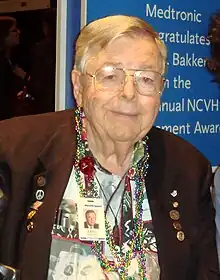 A view of The Bakken Museum from the medicinal garden | |
| Established | 1975–1976 |
|---|---|
| Location | 3537 Zenith Avenue South, Minneapolis, Minnesota, United States |
| Coordinates | 44°56′17″N 93°19′15″W / 44.93806°N 93.32083°W |
| Type | Science museum |
| Director | Alissa Light |
| Website | www |
The Bakken Museum (/ˈbɑːkən/ BAH-kən) is a science museum located in Minneapolis, Minnesota, United States. This science museum was founded by Earl Bakken, the co-founder of Medtronic in 1975. The museum features interactive exhibits about science, technology, and the humanities. The museum features an extensive exhibit centered on Mary Shelley's novel Frankenstein.[1]
Collections and exhibits
Approximately 11,000 written works, and about 2,000 scientific instruments are stored at the museum. Some specifically for electrophysiology and electrotherapeutics. Significant holdings include works by Jean Antoine Nollet, Benjamin Franklin, Giovanni Battista Beccaria, Luigi Galvani, Giovanni Aldini, Alessandro Volta, Guillame Benjamin Amand Duchenne, and Emil Heinrich Du Bois-Reymond and the journals Annalen der Physik, the Philosophical Transactions and Proceedings of the Royal Society and Zeitschrift für Physik.[2] The museum has a Frankenstein exhibit; the combination of electricity and medicine seen in Mary Shelley's novel and the subsequent 1931 film version starring Boris Karloff was a direct inspiration on Earl Bakken to pursue his interest in invention, which would lead to his invention of the pacemaker and founding of Medtronic.[1]

Permanent exhibits include the following:[3]
- Spark is The Bakken Museum's newest exhibit exploring the cycles of innovation and inspiration.[4]
- Frankenstein’s Laboratory is an object theater featuring Frankenstein’s monster.
- Deep Roots: Plants as Medicine discusses modern preconceptions about the relationship between plants and wellness.
- Ben Franklin’s Electricity Party allows visitors to try out electric party tricks similar to those conducted by Ben Franklin and other scientists during electricity parties in the 1700s.
- Mary and Her Monster See Mary Shelley’s magic bookcase filled with artifacts and books from The Bakken collection, solve the puzzle of Frankenstein’s story illustrated by artist Zak Sally, and meet a living portrait of Mary that allows visitors to hear about the people, science, art and culture that inspired her.
The Florence Bakken Medicinal Garden and a statue of Hermes or Mercury, the messenger god of Ancient Greece and Rome, are focal points of the grounds. A newspaper reporter once said the venue "seems a throwback to another time when skilled craftsmen shaped stone, wood and glass into places with lasting appeal".[2]
History

The Bakken was founded by inventor Earl Bakken, who founded the medical technology company Medtronic in 1949.[5] Bakken had a lifelong interest in electricity and invention; as a boy, the self-described "nerd" designed a rudimentary electroshock weapon in school to fend off bullies.[6][7]
At Bakken's suggestion in 1969, Dennis Stillings, who at the time worked for Medtronic in its library, began to acquire books and devices. By 1974, the collection was well known among antiquarians and was offered two lots of early electrical devices. At first stored at the Medtronic headquarters in Saint Anthony Village, Minnesota, the collection by 1975 occupied a floor in the Medtronic branch office in Brooklyn Center, Minnesota and in 1976 began to be moved to its present location.[8]
Formerly funded by the museum, the Bakken Quartet performed chamber music on the premises. Today, the group is named the Bakken Trio and performs in Saint Paul, Minnesota.[9]
Facility

Architect Carl A. Gage originally constructed the building between 1928 and 1930 as the home of William Goodfellow, who sold his dry goods store in 1904 to George Dayton, founder of today's Target Corporation. A combination of 16th-century English styles including Tudor and Gothic Revival, the home was named "West Winds" and contains "dark wood interior paneling, open-beamed ceilings, grouped and arched windows and stained glass". The original home had fifteen rooms and eleven bathrooms. When he died in 1944, Goodfellow donated the buildings to the Girl Scouts. The family of Richard Cornelius lived there between 1953 and 1976, after which the house became the Bakken Museum.
In 1999, the museum completed an expansion that doubled its size from 13,000 sq ft (1,208 m2) to 25,000 sq ft (2,323 m2).[10] A 1,200 sq ft (111 m2) underground vault built in 1981 protects the collection with a constant temperature of 65 °F (18 °C) and 55 percent relative humidity.[8]
Gallery
.jpg.webp) A Frankenstein display
A Frankenstein display Flower in a Bakken garden
Flower in a Bakken garden Bakken Museum sign
Bakken Museum sign Inside the museum
Inside the museum Theremin display, which visitors can play
Theremin display, which visitors can play
References
- 1 2 Rana, D. (2021). A Frayed New World: From Science Fiction to Society. Notion Press. p. 12. ISBN 978-1-68554-027-2. Retrieved 2023-06-02.
- 1 2 Rhees, David J. (2002). "The Physical Tourist: Physics in Lake Wobegon: A Tour of Three Minnesota Museums of Science and Technology". Physics in Perspective. Basel: Birkhauser Verlag. 4: 236–240. doi:10.1007/s00016-002-8365-5.
- ↑ "Youth Programs". The Bakken Museum. Retrieved 2023-06-12.
- ↑ https://www.startribune.com/minnesota-s-quirky-bakken-museum-reinvents-itself-with-4-5m-face-lift/572674982/
- ↑ "Earl E. Bakken Timeline". Earl E. Bakken. Archived from the original on 2007-08-19. Retrieved 2008-01-07.
- ↑ Spencer, William H. (2001). Hurst, J. Willis; Fye, W. Bruce (eds.). "Earl E. Bakken". Clinical Cardiology. 24 (5): 422–423. doi:10.1002/clc.4960240515. ISSN 1932-8737. PMC 6655043.
- ↑ Hebrew University of Jerusalem Institute of Chemistry: Earl E. Bakken Archived 2007-12-05 at the Wayback Machine
- 1 2 Steinke, Cynthia A. (1994). History of Science and Technology: A Sampler of Centers and Collections of Distinction. Haworth Press via Google Books Limited Preview. pp. 114–115. ISBN 1-56024-721-5. Retrieved 2008-01-07.
- ↑ Gehrke, Karl (November 18, 2005). "Bakken the saddle for a new season". Minnesota Public Radio. Retrieved 2008-01-07. and "Series Program and Calendar". Bakken Trio. Retrieved 2008-01-07.
- ↑ ""West Winds" Home of The Bakken Museum in Minneapolis Minnesota". The Bakken. Archived from the original on 2007-10-20. Retrieved 2008-01-07.
External links
- "The Bakken". Retrieved 2008-01-07.
- "Photos by Flickr user The Bakken Museum". Flickr. Retrieved 2008-01-07.
- "Earl E. Bakken Timeline". Earl E. Bakken. Retrieved 2014-08-15.